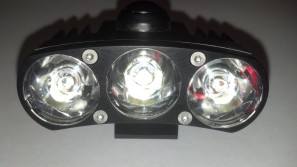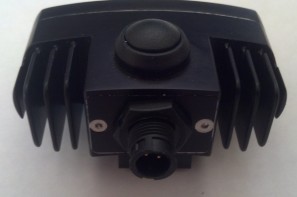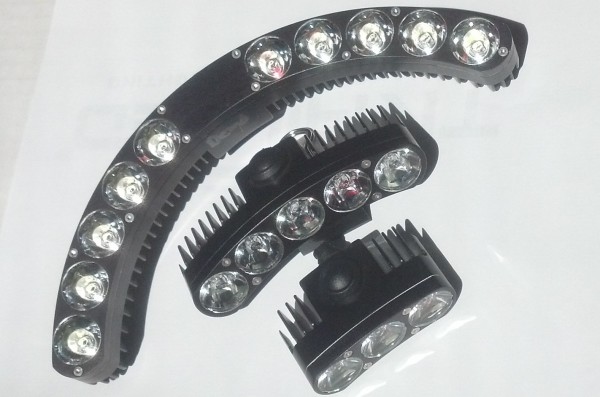
UPDATES: Mounting ring clarification, longer battery life, handlebar bracket included with XXX and DS
Night riding season is upon us and after ten weeks running the Halo, DS, and XXX light systems from Texas based Trail LED, we are very impressed with the industry leading light levels and quality craftsmanship. Set aside the wild looks for a minute and let’s just talk performance. The lights are incredibly bright – Trail LED claims 6,000 lumens for the 10 lamp Halo, 3,000 lumens for the five lamp DS , and 1,800 lumens for the three lamp XXX. While we don’t have the equipment to test those claims, our riding experience demonstrated that each system was significantly brighter than similarly priced systems with roughly the same claimed power. When there are lights with similar claimed outputs, that is – there aren’t too many 6,000 lumen bike lights out there. The single power/mode button is well placed, easy to use with gloves, and offers a satisfying click. The unique if inelegant mounting system -tan colored surgical tubing bands- combined with their helmet hugging shape, reduced neck fatigue and skull inertia compared to traditional coal miner style light mounts. The surgical tube “mounting rings” hold the lamps infinitely better than the Velcro straps offered by most competitors, they do not snag your helmet pads the way Velcro does, and they will never require zip-tie reinforcement. The optional bar mount included with the XXX and DS is simply brilliant. The batteries are compact, easy to carry, interchangeable with all three lamps, and spares are half the cost of their competitors. Criticisms, and specifics on each system, after the jump… Across the models, we do have a couple of small complaints around functionality. The tubing used to attach the lights is just plain ugly, especially compared to the exceedingly well crafted components themselves. Trail LED informed us that the bands are clear when new, but they yellow with sun exposure, and the bands included with our demo lights were quite old. Taking the light on and off is nowhere near as easy as a clip mount, and getting the setup so it is pointing where you want it is tedious. We would like to see Trail LED include a spare set of shorter mounting rings, and perhaps develop a bracket that can stay mounted to the helmet, which a lamp can clip into. This is nitpicking, but there are six different flash options, which we found to be three or four too many. The patterns are not documented in the manual, so even if you do find a favorite, it takes you forever to find it again on your next ride. To completely contradict that statement, we would like a new setting that offered a constant low light that then spiked brighter – versus on and off – so as to serve both your ability to see the road and drivers’ ability to see you.
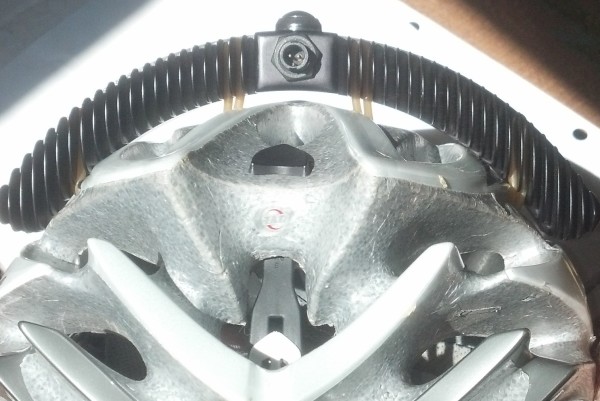
The bayonet mount for the power cord is the same on all three models. It’s sturdy and been reliable, but it is plastic and tiny. We never had an issue with it, and you may never break one, but considering the level of craftsmanship in the light body, we would have liked to see an oversized aluminum knob that would be easier to manipulate in the dark with gloves on, and increase our confidence that we will not accidentally snap it off.
Close ups of the XXX give a good sense of the quality workmanship on all three light systems. Grady Pace CNCs and assembles the lights himself at his Plano, Texas, workshop. The bling factor here is pretty high, you get to support a small business that supports the DFW riding scene, and you get to dramatically improve the reputation of Plano for the sort of cyclist it produces. On to the individual light systems…
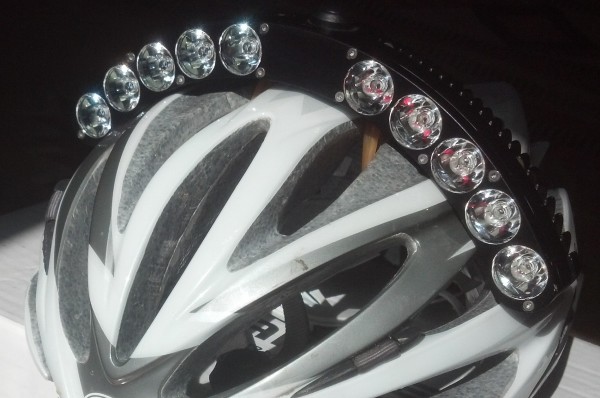
Trail LED Halo
The Halo is bright enough to burn ants. The resolution and color you can see is simply remarkable. You can point the light further ahead of you, not only because even the secondary penumbras are brighter than most lights, but because you are still getting incredible visibility 20 or 30 meters down the trail. On the road, you can practically point the light at the horizon, and feel confident that everyone is going to see you coming. Despite weighing 190 grams, it does not feel heavy. The low profile keeps it out of harms way, and based on our passing knowledge of laminar flow, should create relatively little drag. With the Halo set on high, we were able to ride steep, technical terrain at daylight speeds. The low setting still kicks out 4,000 lumens and doubles life to four hours, which is still brighter and longer lasting than most products on the market, while seeming to produce “better” light. Trail LED claims that the wide lamp array casts light in such a way so that you can better process depth of field. We will not go so far as to validate this claim, but, as stated above, the light just seemed better. If your battery hits critical capacity, it will kick over to emergency mode giving you 30 minutes at a very respectable 600 lumens. In case you live above the arctic circle, at full charge it can run on emergency for days. With that sort of power comes responsibility. On high, the light borders on being dangerous. If you are riding in a group, you are in the front. Period. You have to put the light in emergency mode whenever you stop and talk to someone or you are going to blind them. On tight trails where trees have smooth, light colored bark, or on a road with lots of new signage, the constant glare of reflected light swooshing past you can be distracting. On the road, we definitely upset some drivers, but no worse than when they high beamed us, so honestly, who cares. Also, you look foolish. Everyone we rode with made a joke about it, our favorite being “you look like Predator.” From a distance, you look less post-apocalypse warlord, and more mid-apocalypse headless cycling deity. Given our experience living in Appalachia, convincing hillbillies that the rapture is upon them – and they didn’t make it – could have some seriously beneficial societal outcomes. Mounting the Halo is not fun. It took us multiple tries to figure out which vent holes to run the bands through so that the light is tilted correctly fore-and-aft on the helmet. Invariably the mounting rings were too long and had to be snaked around the cooling fins to use up the slack. If you start riding, and decide the light is pointing too low or too high, you have to take your helmet off and redo the straps – now in the dark with gloves on – which is annoying. If you want to permanently adhere the lamp to a smooth helmet with the included patches it is going to be a serious endeavor, mostly because there is little chance that the curvature of the light is the same as your helmet. Of course, you could have a spare helmet that the Halo stays on permanently. Considering that you would have already shelled out $1,119 for the Halo, buying an extra helmet probably will not that big an impact on your bike budget.
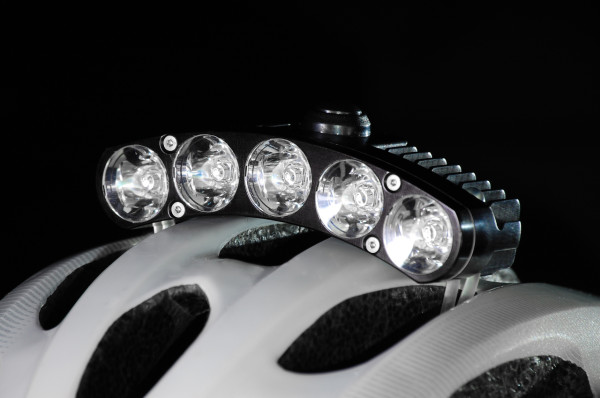
Trail LED DS
For a seriously bright light that does not require selling a bike to finance, the DS is hard to beat. The shorter width made it much easier to get mounted the way we wanted it, but the distance between the lamps still made a noticeable difference in the contrast and resolution of illuminated objects. It’s 100 grams are barely noticeable when mounted, which is a significantly easier process than with the Halo, and some of the blink settings are so bright and obnoxious that it gets drivers’ attention in full daylight. Trail LED claims 90 120 minutes of burn time at 3000 lumens and 3.25 hours at 1,500 lumens, which we found to be about spot on with a new battery we did not test. The 300 lumen emergency setting will last for 30 minutes if it automatically kicks in, and on a full battery it will outlast the night. The DS costs $549.99.
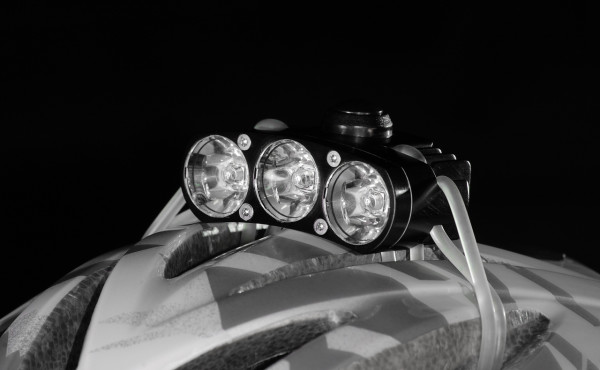
Trail LED XXX
Without a bottomless budget, the $349.99 XXX is the light we would buy. You can leave it mounted all the time, because you simply do not even notice that the sub-50g unit is there. On the high setting, you get 1800 lumens for 2.5 3 hours with a new battery we did not test, low gives you half the light for twice the time, and the dim 200 lumen emergency setting gives you 30 bonus minutes to find the car; on a full battery it will burn for an entire day. High produces enough light for fast or technical riding and the XXX might be the ultimate high end commuter light. Again, there are way too many blink settings, but on long road rides at dusk being able to cycle through different flash patterns gave our eyes a bit of a rest. 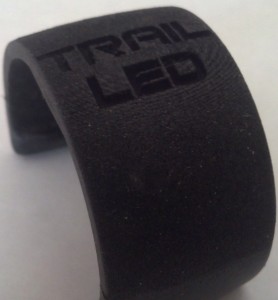
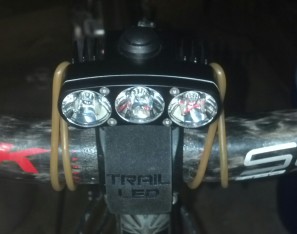 Trail LED recently released this ingenious handlebar bracket
Trail LED recently released this ingenious handlebar bracket for use with that comes with the XXX or DS, although we can not imagine why you would use the latter as a bar light. This C-shaped plastic clam shell sits in front of the face plate of your four-bolt stem – a two bolt faceplate is too ovalized for the bracket to stay put. It has no structural value on it’s own, but you sit your light on the flat section above or below the stem, wrap the included tubing, and you are good to go. The bracket comes with a heavy duty Velcro strap so you can attach your battery to the bike frame. We were surprised how sturdy the bracket proved to be, with no slippage or jostling even on rooty trails with the occasional awkward drop. While the bracket will not stay on without the light strapping it in place, it prevents you from having to reorganize the remainder of the crap in your cockpit – we were able to mount the light above the faceplate without interfering with a GPS on top of the stem tube. The mount comes with the XXX and DS, or can be ordered for $19.99 and is not included with any of the systems. 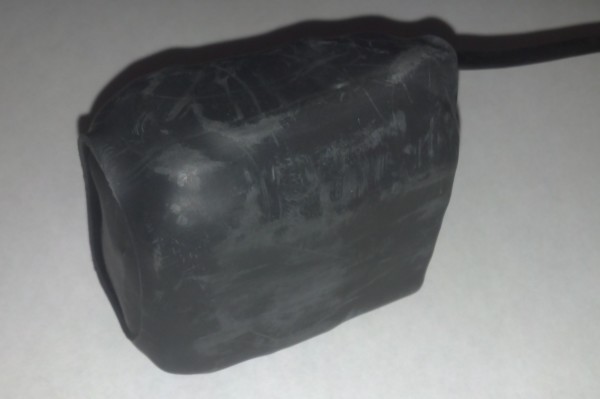 Ah, the lowly battery. Rarely discussed much, it is what makes or breaks your ride. Trail LED is refreshingly forthcoming about their batteries: the lithium polymer cells will retain 80% of their original capacity after 500 charge cycles. They offer two batteries, both of which work interchangeably with all three systems. Pictured above is the standard battery we tested but Trail LED has since upgraded that ships with the DS and XXX. Spares will only set you back $50, which is remarkably inexpensive. It measures about 75 x 60 x 45mm, weighs 285g (claimed) and is encased in a innertube-like rubber that is just tacky enough to make it sit tight in a jersey pocket. Charge time is two hours with the giant (think 90s laptop) 12-volt charger. The “extended life” battery that is included with the Halo is essentially two of these guys strapped together, measuring roughly 140 x 50 x 50mm and weighing 570g. It also takes two hours to charge. A spare extended life battery only costs $85, will tuck neatly into a jersey pocket with room to spare for tools or snacks, making it a very tempting upgrade to double your ride time with the DS and XXX. For solo unsupported overnight riding, Trail LED offers the Super Dave package which includes the DS light system with two small batteries and one large battery for $649.99 – effectively saving you $35 – giving you enough power to burn 3,000 lumens for an entire night. Trail LED sells all products directly from their website. TrailLED.com
Ah, the lowly battery. Rarely discussed much, it is what makes or breaks your ride. Trail LED is refreshingly forthcoming about their batteries: the lithium polymer cells will retain 80% of their original capacity after 500 charge cycles. They offer two batteries, both of which work interchangeably with all three systems. Pictured above is the standard battery we tested but Trail LED has since upgraded that ships with the DS and XXX. Spares will only set you back $50, which is remarkably inexpensive. It measures about 75 x 60 x 45mm, weighs 285g (claimed) and is encased in a innertube-like rubber that is just tacky enough to make it sit tight in a jersey pocket. Charge time is two hours with the giant (think 90s laptop) 12-volt charger. The “extended life” battery that is included with the Halo is essentially two of these guys strapped together, measuring roughly 140 x 50 x 50mm and weighing 570g. It also takes two hours to charge. A spare extended life battery only costs $85, will tuck neatly into a jersey pocket with room to spare for tools or snacks, making it a very tempting upgrade to double your ride time with the DS and XXX. For solo unsupported overnight riding, Trail LED offers the Super Dave package which includes the DS light system with two small batteries and one large battery for $649.99 – effectively saving you $35 – giving you enough power to burn 3,000 lumens for an entire night. Trail LED sells all products directly from their website. TrailLED.com
